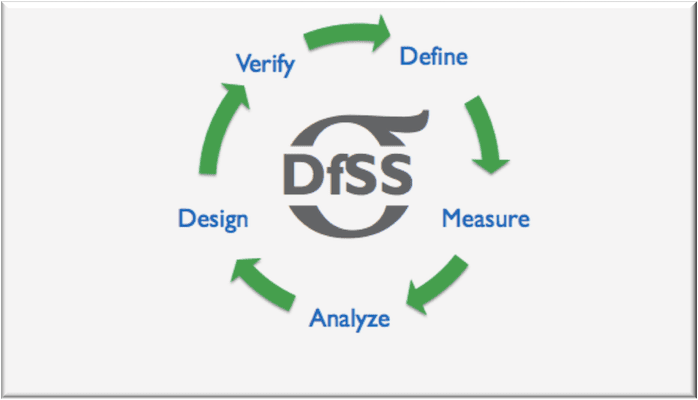Table of Contents:
What ia s Design for Six Sigma Black Belt?
Design for Lean Six Sigma (DFSS) Black Belt is a process that improves the quality of products and services by reducing variation at their source. The DFSS process involves a systematic approach to the design, deployment, improvement, and maintenance of products and services through data analysis and experiments. It’s important to reduce waste and increase customer satisfaction by developing products and services that work better, are more efficient, useful, safer, and last longer. You’ll find some DFSS industry examples at the end of the article.
DFSS for lean six sigma is all about innovation. However, there must be clear goals and objectives before innovative thinking can occur. DFSS is often referred to as lean thinking applied in product design. Its premise is that if a product’s design can be improved, so can the process of its development.
The process starts with the identification of a problem or opportunity (i.e. customer wants something). Next, the root cause is identified using qualitative techniques such as interviews or surveys. The next step is to brainstorm potential solutions using various methods such as affinity mapping, mind mapping and affinity diagramming. Once all possible solutions have been identified, they are then prioritized according to their impact on customers’ wants and needs as well as cost feasibility. After prioritization is complete, solution development starts with prototyping and testing in the environment it will eventually be deployed. This testing includes both qualitative feedback from customers and quantitative metrics (from operations records). After the solution passes testing, it can then be implemented into production/operations lines.
Three Benefits of DFSS (Design for Six Sigma)

Design For Six Sigma (DFSS) is a tool that Lean Six Sigma applications use to design. It has three major benefits.
1. It improves communication between all stakeholders, including customers as well as employees.
You can make sure everyone understands what you are trying to achieve and why by involving all these groups in the design process right from the beginning. This prevents confusion later in the project, when people are more focused on their individual tasks and less on working together to achieve a bigger goal.
2. It promotes standardization in an organization or company.
When every design follows the same process and uses the same tools, it becomes much easier for new employees to understand how things work and get up-to-speed quickly–as well as for current employees who may have been laid off or otherwise left the company due to downsizing or restructuring initiatives such as mergers/acquisitions (M/A) or divestitures/liquidations (D/L).
3. DFSS helps to reduce waste because each component of a project is only used for one purpose.
If you have three products in mind, but only two of them are finished, one component will be used. This is wasted effort.

What is DFSS and why should you care?
The name of DFSS sums up the importance of DFSS: It helps companies design products that optimize for customer experience and not just be good enough. This is vital because it allows companies the opportunity to improve in ways that are not possible before.
You can create amazing products and services that your customers will love if you focus on quality and value rather than cost-cutting.
Three best practices for DFSS planning
When you think about DFSS, there are several best practices.
1. When you start a new project, or process, use DFSS.
This helps you to identify potential problems before you spend time or money designing a product.
2. To ensure that your design process is effective and meets all of your needs, use a structured approach.
This will ensure consistency at all stages of implementation. If there are any gaps, it could lead to errors later on.
3. Your team members should understand their roles in the overall scheme of things.
They can be involved in every phase of development and provide feedback when necessary. This allows for changes to be made before moving onto the next phase. This prevents future problems from occurring (e.g., during implementation).
An industry example of DFSS
The Toyota Production System is a perfect example of DFSS in the industry. TPS has been shown to be one of the most successful manufacturing processes ever. This DFSS example is due to its focus on quality design and not just improving product quality after it has been produced. This ensures that every part is designed to be of the highest quality, from conception to completion.

Frequently Asked Questions about DFSS
Q. What’s the difference between Six Sigma & Design For Six Sigma?
A: Design for Six Sigma is a process that ensures quality in the design and production phases of a product. Although it is different from Six Sigma because it focuses more heavily on the design stage, both are part of Lean Six Sigma which employs a variety of techniques to increase efficiency, reduce waste and increase profitability.
Q. How can DFSS help my company improve its products and services?
A: Using DFSS principles in your business can help you improve your products and services, reduce defects, increase quality and consistency, improve customer satisfaction and loyalty and save money through reduced waste. You will also be able to maintain a competitive edge over other companies that don’t follow DFSS principles. Using DFSS can also improve employee morale and give them a sense that they are empowered to do meaningful work that has an effect on the bottom line.
Q. Are DFSS/DMAIC the same thing?
A: In short, no. DFSS employs specific tools and methods to design designs that meet customer needs. DMAIC, on the other hand, is an overall improvement process that encompasses all aspects of a project or business. DMAIC focuses more on the improvement side of the project while DFSS focuses only on the design. Both of these are essential parts of Lean Six Sigma practices in your company’s process.
The Bottom Line
DFSS, as a design approach, combines statistical measurements with design principles in order to optimize processes and achieve desired outcomes. Although DFSS is primarily focused on manufacturing processes, DFSS could be used in any industry to create a strategy that works for your business. When tangible results are your goal, this methodology can be a game changer.



















